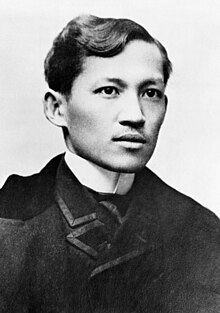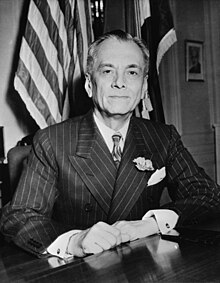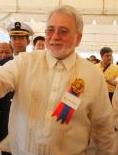|
Spanish Filipinos
Spanish Filipino or Hispanic Filipino (Spanish: Español Filipino, Hispano Filipino, Tagalog: Kastílâ Filipino, Cebuano: Katsílà Filipino) are Filipinos of Spanish descent. The term may also include Filipino mestizos of Spanish ancestry and Hispanicized native Filipinos who identify with Spanish culture and may or may not speak the Spanish language.[20] Forming a part of the Spanish diaspora,[20] the heritage of Spanish Filipinos may come recently from Spain, be descendants of the original Spanish settlers during the Spanish colonial period, or from Spain's colonies in Latin America (such as Mexico). Many of their communities in Spain, Mexico, the United States, Australia, Canada, Latin America and the Philippines trace their origin to the early settlers from Europe and Southeast Asia during the Spanish colonial period and in recent overseas migration in the 1900s. In the Philippines depending on the specific provinces, in the late 1700s to early 1800s they formed as much as 19% in the capital city of Manila at formerly named Tondo province,[1]: 539 and about 1.38% of the Ilocos region,[2]: 31 2.17% of Cebu[2]: 113 or 16.72% of Bataan[1]: 539 and other parts of the country. The Spanish population that settled in the Philippines during the colonial period were originally referred to as "Filipinos".[21] Spaniards, Latin Americans and Spanish-speaking Filipinos are referred to by native Filipinos as "Kastila", a word for "Castilian" which means the region and language of Castile, or an individual of Spanish heritage. Native Filipinos in historical terms are referred to by the Spaniards as "gente morena" (brown people)[citation needed] or "Indio" (a word for "Indian" or native people). Filipinos of Spanish backgrounds numbered at about 4,952 people, while Mestizo Filipinos of mixed native Filipino and European ancestry made up about 5% of the Philippines' population during the 1700s.[1][2] The abrupt decline of Spanish Filipinos as a percentage of the population is due to the events of the Philippine Revolution during the Philippine Republic in the late 1800s, as Filipinos of Spanish heritage choose to identify themselves as pure native Filipino, as part of establishing a united national identity in the country,[22] or some have relocated back to Spain, or have migrated to other countries during that period. During and after the Philippine Revolution, the term "Filipino" included people of all nationalities and race, born in the Philippines.[23][24][25] Today, Hispanic Filipinos are found in all social classes worldwide, from upper wealthy to lower poor disadvantage backgrounds, and from high profiled individuals to ordinary unknown people. They have long integrated into the native communities living their lives as ordinary citizens. However most of the successful individuals are present in economics and business sectors in the Philippines and a few sources estimate companies which comprise a significant portion of the Philippine economy like International Container Terminal Services Inc., Manila Water, Integrated Micro-Electronics, Inc., Ayala Land, Ynchausti y Compañia, Ayala Corporation, Aboitiz & Company, Union Bank of the Philippines, ANSCOR, Bank of the Philippine Islands, Globe Telecom, Solaire Resort & Casino, and Central Azucarera de La Carlota, to name but a few are owned by Hispanic Filipinos.[26][27][28][29][30] History The history of the Spanish Philippines covers the period from 1521 to 1898, beginning with the arrival in 1521 of the Portuguese explorer Ferdinand Magellan sailing for Spain, which heralded the period when the Philippines was an overseas province of Spain, and ends with the outbreak of the Spanish–American War in 1898. The Spanish discovery of the American continent by the Italian explorer Christopher Columbus in 1492, an expedition sponsored by Queen Isabella I of Castille and King Ferdinand II of Aragon,[31] laid the foundation of settlements and explorations in the New World.[32] Spain became the first European country to permanently colonized the American continent in 1492.[33] In 1541, Spanish explorer Ruy López de Villalobos was commissioned by Antonio de Mendoza, the viceroy of New Spain and first colonial administrator in the New World, to send an expedition to the Philippines to establish a larger Spanish presence there as a base for trade with the Spice Islands and China and to extend Spanish control over the Moluccas in the Portuguese East Indies.[34] The expedition ultimately failed, with Villalobos dying in a Portuguese prison on Ambon Island in 1546. In 1564, conquistadors led by Miguel López de Legazpi, prompted the colonization of the Philippine Islands that lasted for 333 years. The Philippines was a former territory of New Spain until the grant of independence to Mexico in 1821 necessitated the direct government from Spain of the Philippines from that year. Early Spanish settlers to the Philippines were mostly explorers, soldiers, government officials, religious missionaries, and among others, who were born in Spain or in Mexico called "Peninsulares" (Spanish migrants living in the colony). Their succeeding generation known as "Criollos" (Spaniards of pure White blood, born and raised in the colony) contributed to the population's development.[35]  For centuries several hundreds of White Spaniards settled in the islands along with their families to start a new beginning in the New World, to take advantage of the rich and exotic resources the colony had to offer. Some of these individuals married or inter-bred with the indigenous Filipino population while most married only other Spaniards. Their descendance that consisted of "Criollos" or "Insulares" and "Mestizos" (those of mixed-blood individuals) became part of the island's indigenous society; some became town officers and farmers, and others became ordinary citizens. Government officials and those of high ranks were granted with haciendas (plantation estates) by the Spanish government. In some provinces like, Vigan, Iloilo, Cebu, Pampanga, and Zamboanga, The Spanish government encouraged foreign merchants from Southeast Asia and the Asian continent to trade in the colony, along with the European and indigenous population, but they were not given certain privileges such as ownership of land. Contacts with White Europeans, social intercourse between foreign merchants, and indigenous people resulted in a new ethnic group. These group were called Mestizos (mixed-race individuals), who were born from intermarriages from White European Spaniards and indigenous Austronesian-speaking Filipino natives. Some of their descendants emerged later as an influential part of the ruling class called the "Principalía" (Nobility) class. The Spanish implemented incentives to deliberately entangle the various races together in order to stop rebellions.[36][37][38] According to a historical colonial conversation that was published, stated by a government official explains: "It is needful to encourage public instruction in all ways possible, permit newspapers subject to a liberal censure, to establish in Manila a college of medicine, surgery, and pharmacy: in order to break down the barriers that divide the races, and amalgamate them all into one. For that purpose, the Spaniards of the country, the Chinese mestizos, and the Filipinos shall be admitted with perfect equality as cadets of the military corps; the personal-service tax shall be abolished, or an equal and general tax shall be imposed, to which all the Spaniards shall be subject. This last plan appears to me more advisable, as the poll-tax is already established, and it is not opportune to make a trial of new taxes when it is a question of allowing the country to be governed by itself. Since the annual tribute is unequal, the average shall be taken and shall be fixed, consequently, at fifteen or sixteen reals per whole tribute, or perhaps one peso fuerte annually from each adult tributary person. This regulation will produce an increase in the revenue of 200,000 or 300,000 pesos fuertes, and this sum shall be set aside to give the impulse for the amalgamation of the races, favoring crossed marriages by means of dowries granted to the single women in the following manner. To a Chinese mestizo woman who marries a Filipino shall be given 100 pesos; to a Filipino woman who marries a Chinese mestizo, 100 pesos; to a Chinese mestizo woman who marries a Spaniard, 1,000 pesos; to a Spanish woman who marries a Chinese mestizo, 2,000 pesos; to a Filipino woman who marries a Spaniard, 2,000 pesos; to a Spanish woman who marries a Filipino chief, 3,000 or 4,000 pesos. Some mestizo and Filipino alcaldes-mayor of the provinces shall be appointed. It shall be ordered that when a Filipino chief goes to the house of a Spaniard, he shall seat himself as the latter's equal. In a word, by these and other means, the idea that they and the Castilians are two kinds of distinct races shall be erased from the minds of the natives, and the families shall become related by marriage in such manner that when free of the Castilian dominion should any exalted Filipinos try to expel or enslave our race, they would find it so interlaced with their own that their plan would be practically impossible".[39] Mexicans, Indigenous Americans and some Black Africans were also brought to the Philippines to work on plantation settlements, as slave workers or settlers working in the colony. Between 1565 and 1815, both Filipinos and people from Latin America and Spain sailed to, and from the Philippines in the Manila galleon trade to Acapulco, assisting Spain in its trade on the colony. Population Colonial statisticsIn the late 1700s to early 1800s, Joaquín Martínez de Zúñiga, an Agustinian Friar, in his Two Volume Book: "Estadismo de las islas Filipinas"[1][2] compiled a census of the Spanish-Philippines based on the tribute counts (Which represented an average family of seven to ten children[40] and two parents, per tribute)[41] and came upon the following statistics:
The Spanish-Filipino population as a proportion of the provinces widely varied; with as high as 19% of the population of Tondo province [1]: 539 (The most populous province and former name of Manila), to Pampanga 13.7%,[1]: 539 Cavite at 13%,[1]: 539 Laguna 2.28%,[1]: 539 Batangas 3%,[1]: 539 Bulacan 10.79%,[1]: 539 Bataan 16.72%,[1]: 539 Ilocos 1.38%,[2]: 31 Pangasinan 3.49%,[2]: 31 Albay 1.16%,[2]: 54 Cebu 2.17%,[2]: 113 Samar 3.27%,[2]: 113 Iloilo 1%,[2]: 113 Capiz 1%,[2]: 113 Bicol 20%,[42] and Zamboanga 40%.[42] According to the 1893 data in the Archdiocese of Manila which administers much of Luzon under it, about 10% of the population was then Spanish-Filipino.[1]: 539 Overall the whole Philippines, even including the provinces with no Spanish settlement, as summed up, the average percentage of Spanish Filipino tributes amount to 5% of the total population.[1][2] Historical terms   These are historical Spanish terms[43] used to identify the different types of names given to the people living in the colony.
Present-day 21st century FilipinosThis category is about a term used to identify the different types of Filipino ethnic groups living on the islands. They are:[47]
ReligionThe majority of Spaniards, Latinos and Hispanic Filipinos are Christians, with most adhering to Catholicism.[48] LanguageSpanish,[49] Spanish creole (Chavacano), English, Tagalog and other Indigenous Filipino languages are spoken in their community. Philippine SpanishPhilippine Spanish (Spanish: Español Filipino, Castellano Filipino) is a Spanish dialect and variant of the Spanish language spoken in the Philippines. Philippine Spanish is very similar to Mexican Spanish due to the contribution of grammar and vocabulary spoken by Mexican settlers in the country, during the Galleon trade. A constitution ratified in 1987 designated Filipino and English as official languages.[50] Also, under this Constitution, Spanish, together with Arabic, was designated an optional and voluntary language.[51] Spanish is now spoken mostly by Hispanic Filipinos, educated Filipinos and Filipinos who chose to speak the language. Most Spanish Filipinos speak Spanish as their first, second or third language as they have shifted to communicating in English and Tagalog and/or other indigenous Filipino languages in the public sphere. EconomyProminent Filipino billionaire businessmen[52] The Hispanic communities in the Philippines play an important part of the society in both economic and traditional identity of the people.[53] The most successful individuals are found in the upper-class society, most of whom are highly educated and are involved in business and economic sectors.[54] They contribute to some of the Philippines's most important investments in infrastructures such as telecommunication, technology, electricity, water, transport, banking, land economy, tourism, sport and entertainment, shipping trade and marketing.[55] LegacyPublic communication in the PhilippinesIn 1899, the First Philippine Republic promulgated a constitution that designated Spanish as the nation's official language.[56] The Philippines was the only Spanish speaking country in Asia, from the beginning of colonial rule in the 1500s until the first half of the 20th century. It held official status for over four centuries and was redesignated as an optional language in 1987. The Philippine government deliberately suspended the use of Spanish language for some unknown political reasons. Discourteous and hypocritical Filipino politicians influenced by third world Southeast Asian[57] corruption, political agendas, a failed government and economic system, extreme poverty and years of bleak uncertain future that still surrounds the Philippines[58] to this day, led to the People Power Revolution in 1986. The government Constitution of the Philippines without conducting a proper western-style election protocol, was controversially changed in 1987. This disrupted the development of the language, which led the Philippines to be an incomplete Spanish-speaking country. Tagalog and English remained as the official languages of the country as they have been in previous constitution. In 1987, the Tagalog language which was called Filipino was promoted as the main language, a language that was chosen by the former Philippine president Manuel L. Quezon in 1935, who himself was of mixed Spanish ancestry. Spanish still remains and continues to be spoken by educated Filipinos, Spanish Filipinos and native Filipinos who chose to speak the language in public. However, it is mostly spoken and used in universities and in Hispanic communities. The Philippines is a member of the Latin Union where the language is used for education in the Instituto Cervantes, in the capital city of Manila.[59] In 2010, the former Philippine president Gloria Macapagal Arroyo, a fluent Spanish speaker,[60] re-instated the language as a compulsory subject to be taught in schools and universities.[61] One of the reasons of change was that she wanted to the Philippines to return to traditional ways of life, be bilingual, competitive, wealthy and respected, and able to compete in the world economy. The other was for global employment demands such as in the call center and business process outsourcing industries. Most Spanish-speaking Filipinos also use English in the public sphere and may also speak Tagalog and other Philippine languages. In addition, Chavacano (a creole language based largely in the Spanish vocabulary) is spoken in the southern Philippines and forms the majority of Zamboanga Peninsula and Basilan region. Culture Hispanic Filipinos share some similarities to cultural practices from people in Latin America and Spain, including a shared history, tradition, names, arts and literature, music, food, religion and language.[62] They have also taken some influences from the United States,[63] as evidenced by their admiration for Anglo-American Popular culture. The National Hispanic Heritage Month is celebrated in the United States by individuals of Spanish Heritage.[64] While in Spain, the Running of the Bulls is a traditional celebration.[65] LiteratureCover of the Doctrina Christiana featuring Saint Dominic with the book's full title. Woodcut, c. 1590. Pages of the Doctrina Christiana, an early Christian book in Spanish and Tagalog. The book contained Latin and Baybayin suyat scripts (1593). "Literatura Filipina en Español"Philippine literature in Spanish ("Literatura Filipina en Español") is a body of original Hispanic literature made by Filipino writers in the Spanish language which was first published in 1593 by Spanish Roman Catholic priest.[66] Today, this corpus is the third largest in the whole corpus of Philippine literature (Philippine literature in Filipino being the first, followed by Philippine literature in English). It is slightly larger than Philippine literature in vernacular languages. However, because of the very few additions to it in the past 30 years, it is expected that the latter will soon overtake its rank. The most popular written Hispanic literature in the Philippines is Noli Me Tángere, a novel written by José Rizal.[67] ArtHispanic art explores the rich history and story of the ancient world, combined with colonialism, religion[68] and contemporary way of life.[69] Music and cinemaHispanic music is a blend of traditional European folk music mixed with Indigenous American-Indian, Indigenous Filipino and African sounds, together with contemporary European, Latino and Anglo-American genre.[70] Films, hip-hop, pop, dance, rock and heavy metal are also popular.[71] CuisineSpanish cuisine is traditionally of European origin. Filipino cuisine is a blend of European and Asian influences.[72] SportFootball is the most watched and played sport in Spain and in Latin America.[73][74] In the Philippines football is also popular particularly among the Hispanic communities and fans of the sport. Tennis, basketball, beach volleyball, volleyball, baseball, boxing, UFC, cycling, motor sports and water sports are also widely appreciated in the Spanish community.[75][76] The game of basketball is one of Spain's most popular sports and is second only to football, played at a professional level, while in the Philippines it is considered its national sport. Traditional and cultural sports such as bullfighting were popular among Spaniards and in Latin America in the early 1900s, but have recently declined in popularity in the 2000s due to the violent nature of the sport.[77] Notable Spanish FilipinosQueen Letizia of Spain[78] Enrique Iglesias, Latin and pop-music singer Carlos Loyzaga, Basketball legend and politician Katarina Rodriguez, Beauty pageant Bruno Mars, Pop and hip-hop singer Princess Leonor of Spain[79] Juan Álvarez,[80] President Princess Sofía of Spain[81] Marian Rivera, Film actress Emilio Aguinaldo, President Paulino Alcántara, Football legend Pilita Corrales, Singer and film actress This is a list of famous Hispanic Filipinos who are recognized internationally for their achievement.[82][83][84] Sport
Art
Music
Films
Fashion
Literature
Economics
Monarch
Journalism
Religion
Politics
See also
Notes
References
Sources
External links
|
||||||||||||||||||||||||||||||||||||||||||||||||||||||||||||||||||||||||||||||||||||||||||||||||||||||||||||||||||||||||||||||||||||||||||||||||||||||||||||||||||||||||||


















